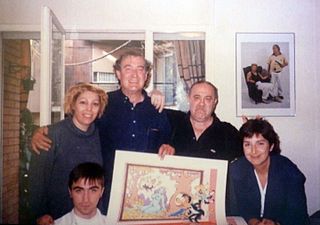Condorito is a Chilean comic book and comic strip series that features an anthropomorphic condor living in a fictitious town named Pelotillehue, a typical small Chilean provincial town. He is meant to be a representation of the Chilean people.

Francisco Ibáñez Talavera was a Spanish comic book artist and writer.
José Escobar Saliente was a Spanish comic book writer and artist, born in Barcelona. He signed as Escobar, and is most famous for his creation Zipi y Zape, as well as the character Carpanta. He was also an author and a theater actor, as well as one of the pioneers of animation in Spain during the 1920s, and worked on early Spanish animated movies, such as La ratita que barría la escalerita.
Spanish comics are the comics of Spain. Comics in Spain are usually called historietas or cómics, with tebeos primarily denoting the magazines containing the medium. Tebeo is a phonetic adaptation of TBO, a long-running (1917–1983) Spanish comic magazine, and sounds like "te veo".

Manuel Vázquez Gallego, was a Spanish cartoonist. He was one of the most important artists of Editorial Bruguera.
13, Rue del Percebe is a Spanish comic book created by Francisco Ibáñez that debuted in the pages of Tío Vivo magazine on March 6, 1961, and quickly became highly popular. The last strip was published in 1984.
Alfons Figueras i Fontanals was a Spanish cartoonist. He created characters such as Aspirino y Colodión or Topolino, el último héroe
Carlos Conti Alcántara was a Spanish cartoonist. He created characters such as El loco Carioco, a kind crazy man who lives in a lunatic asylum.

Francesc CapdevilaGisbert, better known by his pen-name Max, is a Spanish artist who has worked in illustration, design, and comics. He is an important figure in Spanish comics, creating such popular characters as Gustavo and Peter Pank early in his career, and more recently Bardín. His clear line style tells humorous, angry, and sad, surrealistic stories.
Pepe Gotera y Otilio, or more complete Pepe Gotera y Otilio, chapuzas a domicilio are Spanish comic characters of the series of the same name created by Francisco Ibáñez Talavera in 1966 focusing on the comic adventures of two bumbling and disastrous workmen.
Rompetechos is a Spanish comic character created by cartoonist Francisco Ibáñez in 1964, protagonist of the series of the same name. Rompetechos is a short and myopic man whose poor vision generates comical situations. Ibánez stated repeatedly that, among his creations, this was his favorite character and due to this he appeared frequently in other series by the author, notably Mortadelo y Filemón.

Guillermo Cifré Figuerola (1921–1962), known by his first name, Cifré, was a Spanish cartoonist, illustrator and animator, creator of some of the most representative characters of the "Bruguera school", such as El repórter Tribulete and Don Furcio Buscabollos, about an unlucky knight and his talking mare in a pseudo-medieval world. Some of his characters were the old bachelor type such as Cucufato Pi or Golondrino Pérez.
Bernardo Vergara is a Spanish cartoonist.
José Peñarroya Peñarroya was a Spanish cartoonist of the Bruguera School, creator of famous characters such as Don Pío or Gordito Relleno. He also was, alongside Cifré, the "official" cover artist of many of the publications of the house, until well into the 1960s. As a result, he is considered one of the "Big Five" of that editorial of the 1950s, along with Conti, Escobar, Giner and Cifré.

Edmundo Fernández Ripoll, better known as Edmond, is a Catalan comic book artist and illustrator, born in 1938 march in Barcelona. His most famous creation was Jan Europa.
Ediciones B is a Spanish publisher, which currently operates as a division of Penguin Random House. Ediciones B is headquartered in Madrid and Barcelona, Spain; with branches throughout Latin America. It was established in 1986, but has its origins in El Gato Negro (1910) and Editorial Bruguera (1940).

Purificación Campos Sánchez, better known as Purita Campos, was a Spanish cartoonist, illustrator and painter.
El botones Sacarino is a Spanish comic character of the series of the same name created by Francisco Ibáñez Talavera in 1963 focusing on the comic adventures of a clumsy bellhop and the disasters he unintentionally caused in the office he worked for.
Miquel Bernet Toledano, better known by the pseudonym Jorge, was a Spanish comic artist. His most famous character is Doña Urraca.

Antoni Batllori Obiols, best known as Toni Batllori, was a Spanish satirical cartoonist, illustrator, and sculptor.







